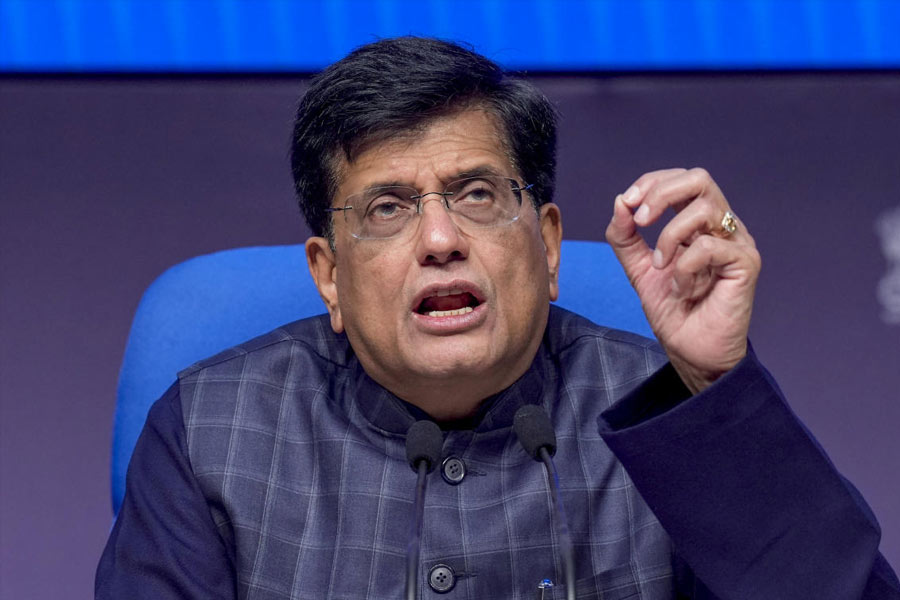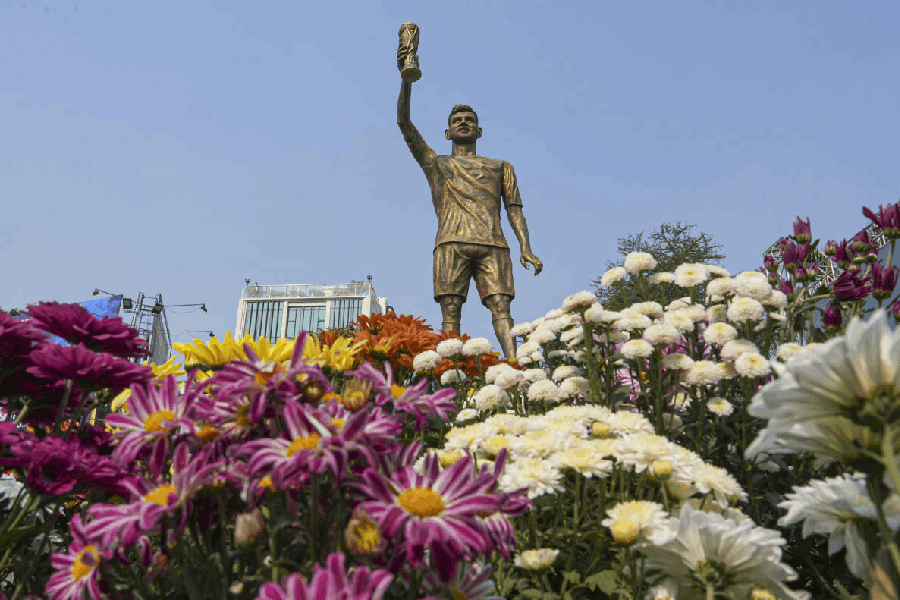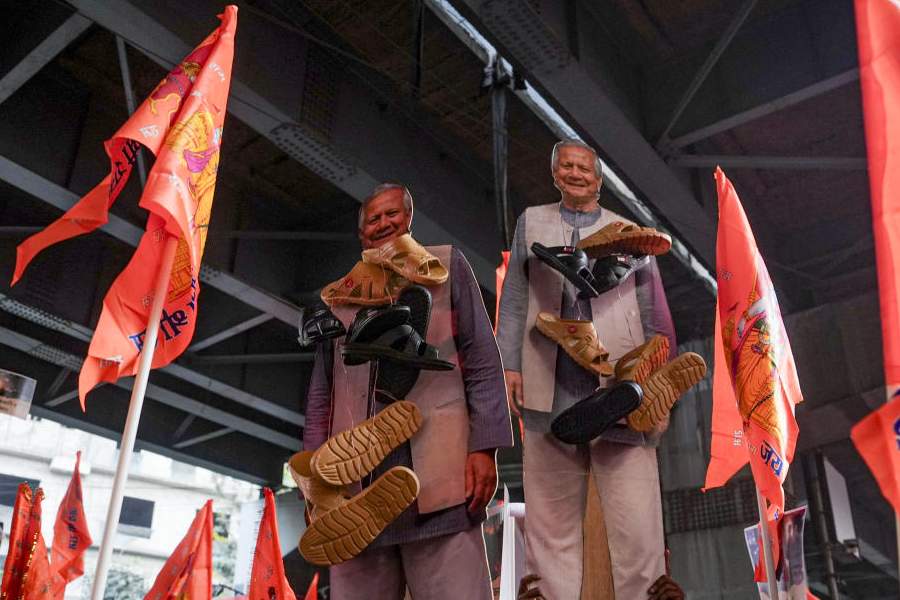 |
| Sudarshan Shetty’s monumental Flying Bus sculpture at Mumbai’s Bandra-Kurla Complex has been drawing the crowds |
It’s called Flying Bus and it’s a monumental 10-tonne sculpture of an icon red double-decker Mumbai bus sporting a pair of huge steel wings. And it has been drawing the crowds ever since it was unveiled at the smart Maker Maxity office block in Mumbai’s Bandra-Kurla Complex.
From curious office-goers to serious art lovers to even children visiting the pizza outlet next door, they’re all thronging to gape at this massive display of public art. But then its creator, Sudarshan Shetty, a leading star of India’s Contemporary art firmament, is a past master of creating a spectacle that draws in the viewer.
Of course, double-deckers no longer ply on Mumbai streets and Flying Bus, which was commissioned by art collector and real estate developer Manish Maker and which cost around Rs 1 crore, is Shetty’s ode to loss — and also change and regeneration. Shetty has conceived the bus’ interiors as spaces that can be used for art shows and also events. The 40-ft-long bus was made to order in Belgaum and its 34-ft-long steel wings were fabricated in Baroda.
“Public art is a very difficult space because it’s going to remain there forever presumably. But I believe that all objects are bound to change in their meaning over time so this allows for that continuous change,” says Shetty.
Shetty has been soaring on the wings of his artistic popularity especially with international collectors and curators. Says curator Ranjit Hoskote: “Sudarshan is larger than the Indian context. He’s among the eight or nine contemporary Indian artists who should, in fact, be seen in an international context, alongside other artists who are launched on similar quests.”
 |
| An installation view of Shetty’s This Too Shall Pass show, which was held at the Dr Bhau Daji Lad Museum in Mumbai in 2010 |
And Lekha Poddar, who with son Anupam, has been an early collector of his work, says: “Sudarshan’s among the top five contemporary Indian artists.”
Shetty, who’s known for his monumental sculptures and installations, has also become extraordinarily prolific. Since 2008, he’s held two major solo exhibitions a year besides participating in prestigious shows like the one at the Guggenheim Museum, New York. Last year, he did a solo show at Galerie Daniel Templon, Paris, followed by the evocative Listen Outside This House at GallerySKE in Bangalore.
“I would have been prolific even earlier had there been such opportunities,” says Shetty.
Consider this. His installation, For All That We Lose — a huge carved wooden gateway with an oscillating sword within — was showcased at the Art Unlimited curated section of the Art Basel fair in 2011. In 2010, he made House of Shades for Louis Vuitton, subverting the idea of the viewer being viewed in this large kiosk of rotating rows of sunglasses. And in 2008, his outdoor sculpture History of Loss drew crowds at London’s Frieze Art Fair. His work is also in major collections like the Frank Cohen one in UK and the Walter Vanhaerents collection in Belgium.
 |
| In his recent Listen Outside This House show, Shetty used text as a starting point for opening up a world of images |
“Sudarshan is one of the very few artists in India who can manage, with great adroitness and formal command, the interplay between flamboyant surface and mysterious depth,” says Hoskote.
Certainly, Shetty is always stretching the boundaries of his art. “It’s very important to look outside your own practice constantly,” he says. Take Listen Outside This House, where for the first time, he used text as a starting point for “opening up possibilities for a world of images”.
“Sudarshan is a very rigorous artist. To see Sudarshan’s work, you have to work a little bit yourself. It’s not the most obvious kind of work,” says his gallerist Sunitha Kumar Emmart of GallerySKE.
Often described as giant toys, Shetty’s works are known for their kinetic energy — he often uses mechanical movements in them — whether it’s a pair of chairs with wings that flap when a viewer presses a lever or as in the famed Love series, a metallic stegosaurus repeatedly mounting a yellow Jaguar car (it’s in the Poddar collection).
Yet, for Shetty, the spectacle is really a device to draw in viewers even as he probes deeper meanings. Themes of futility, mortality, loss, the absence of the body and artifice run through his work. And skeletons — he buys real skeletons, dismantles them and then casts them in other materials — dangling swords, flowing liquids (referring to bodily functions) and everyday objects are recurrent motifs.
Much of his art, Shetty admits, stems from his interest in theology, which also comes from the fact that his father was a famous Yakshagana performer. “A lot of my ideas come from my interest in the Hindu theological discourse,” says Shetty. He’s intrigued by ideas of cyclicity and the balancing act between “the positions of giving meaning to your life and the meaninglessness of it”. “Futility is only a condition for meaning-making and loss is a condition for regeneration,” he says.
Actually, Shetty rejected the Yakshagana tradition for years and only began rediscovering it after his father’s death. His father was famous for playing negative roles and yet making them heroic through his extemporary arguments. “My father would always say that it’s important to entice the audience. And one of my early issues was how do you bring in a viewer,” says Shetty. He began doing that by using everyday objects in surprising ways and by creating an amusement parlour-feel with his toy-like works.
 |
| Shetty’s works have been appearing regularly in large international shows and events. Seen here is History of Loss, his outdoor sculpture at the Frieze Art Fair in 2008 |
Emmart says that Shetty is “interested in building a discourse”. And he’s also always drawing on his other eclectic interests. He’s deeply interested in architecture and he reads everything from fiction to philosophy. He’s also passionate about Indian classical music and films. If he’s inspired by the French filmmaker Robert Bresson, he’s equally influenced by the manner in which Kumar Gandharva stepped into an existing musical tradition and reworked it in new directions. “I find Kumar Gandharva very close to what I’d like to do,” he says.
Gallerist Shireen Gandhy of Chemould Prescott Road says: “Sudarshan has really under- stood scale.”
Yet, he does tiny works too and Emmart says he’s popular with young people as well. His works can range from Rs 15,000 (for a small edition work) to the Rs 69 lakh that Emmart sold one work for recently.
 |
| Shetty’s famed Love series included works like this one of a metallic stegosaurus mounting a yellow Jaguar car |
Shetty admits that “money is important because it makes things possible. But I don’t save anything, I just put it all back in my work”. As for the recognition, he says: “I was well known even when I was living in Dadar and people paid me to paint portraits of their relatives who had died.”
That equanimity is more recent though, and Emmart remembers him as being “forever the angry young man earlier”. But then, it’s been an eventful journey.
Actually, Shetty has known he was an artist ever since his art teacher in his Kannada-medium school encouraged his talent. “I thought I was an artist. But I came from a very poor family so going to J.J. (School of Art) seemed like a rich man’s prerogative,” he says.
That’s why he first did a B.Com, and only joined J.J. later. Of course, when he graduated in 1985 — he studied painting but was already working with objects — there were no avenues for young artists. So for two years, he did little work. Then in 1987, he got a fellowship at the Kanoria Centre for Arts in Ahmedabad, which gave him the opportunity “to do things hands on” and also interact with architects and designers. In 1990, he moved to Delhi to work on a commissioned installation, which was later destroyed in a fire. But he kept participating in group shows and even had his first solo show in Rotterdam in 1991, much before his first solo in India in 1995.
 |
| Paper Moon, Shetty’s first solo show, which created a stir in the art world, came 10 years after he graduated from art school |
That was Paper Moon and it was funded by industrialist Gautam Thapar. By then he was back in Mumbai, and his large works like the pink rocking horse with a tap on its chest created a stir for creating a new artistic language.
Paper Moon opened up opportunities like residencies and shows abroad. Yet, Shetty never made any money and most of his early work is lost because he couldn’t afford storage space. It was only in 2003 with Consanguinity — with its famed bathtub with scissors snapping underwater — that Shetty began selling his work. Subsequently, the tie-up with GallerySKE brought him exposure abroad.
Through SKE, Shetty’s now represented by Galerie Daniel Templon in Paris, Gallery Krinzinger in Vienna and Jack Tilton Gallery in New York. And if he’s done big shows like Love in 2006 and This Too Shall Pass in 2010, he’s also experimented with works like Six Drops, a virtual piece of animated frames. “I think with the coming of the market, it became possible to do a lot of things that had seemed impossible earlier,” he says.
 |
| Shetty’s installation work For All That We Lose was showcased at the Art Basel fair last year |
Now, he’s constantly dashing between his workshop in Mulund and between Bar-oda, Ahmedabad and Pune, where he outsources casting, fabrication and mechanical work to workshops. He has just started working on his big solo show at Gallery Krinzinger in September. And there’s a possible show in Berlin in 2013 too. Besides, he’s working on a book on his work, and there are two private commissions in India too. “I am spacing it out now because I want to do other projects like this book,” he says.
But he’s most keen on working out his aesthetics through the traditions that are closest to him. He admits that Kumar Gandharva’s music and watching recently-discovered recordings of his father’s performances evoke a “biological response” in him while Western art stirs a more “cerebral” response “though that is also invariably exciting”.
“I think it stems from the fact that we live a certain way and aspire to be something else all the time. So I’m trying to see if all this that I feel close to can become a part of my aspiration. It’s challenging but I hope I will be successful one day,” he says.










